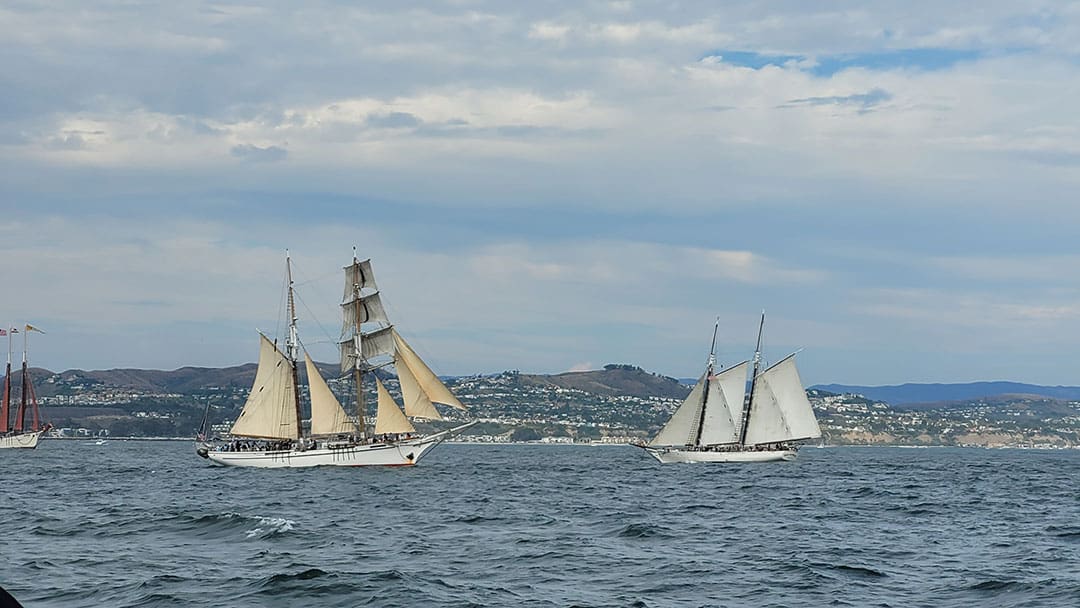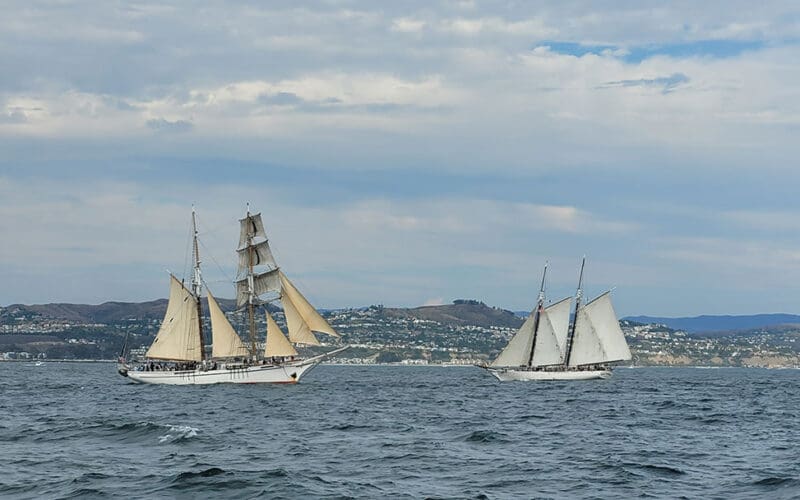
By Rob Laymon
The three-day Dana Point Maritime Festival takes place every year in September. It’s a good specimen of the thing called a sail festival, that strange waterborne Saturnalia dear to the sailor’s heart. Other festivals take place in California, including in San Diego, sometimes sporadically, sometimes just once or twice. But the Dana Point festival has proved tenacious.
Exy Johnson, the schooner I was captaining, had motor-sailed to the the Dana Point Sail Festival in southern California from San Pedro. We departed with our cannons all aglint and our cartridges packed. Two other boats from the Los Angeles Maritime Institute, Irving Johnson and American Pride joined us. These two and Exy Johnson would make a large part of the tall ship spectacle at the event. Also a large part of the noise.
“This was our 39th annual event this year,” said Kaitlyn Davidson, growth marketing manager for the Ocean Institute, which hosts the event. “It was originally called the Tall Ships Festival, but was rebranded so we could include more of the culture and history that we get to teach kids through the year.”
We on Exy Johnson were ready for some noisy proceedings. Friday we lay about and kept things shipshape in preparation for the havoc, which would begin on Saturday. At 10 a.m. it came, in the form of crowds crossing our deck, and marveling at the baggywrinkles, and asking if we had gotten there by water, and identifying our dorade vents as speaking tubes, and guessing wrongly which was the front of the boat, and noting the presence of a “kitchen” amidships, and goggling at the belaying pins and bumping along like tourists in a museum.
These were the deck tours, a chance for the non-sailor to come aboard a tall ship and check things out, the crew answering questions and smiling and rotating stations throughout the ordeal, from the wheel to the foredeck to the top of the gangway to the bottom of the gangway. This went on until 3 p.m. when the boats emptied and everyone drew a deep breath in preparation for what was to come.
What came next is a curious tradition among west coast tall ships. Somewhere in the dim long ago, someone with an adventurous flair conceived the notion that sailing ships navigating closely and shooting cannons at each other would make a fun afternoon, especially if the spectators were on the boats receiving fire.
Thus the cannon battle sail, an echo of olden warfare brought to the modern age as entertainment. Old hands speak of cannon battle sails as if they were just another of the strange gambits by which the tall ship remains in life, as indeed they are. Cannon battles rage up and down the west coast in the summer, involving at least two but more often five or six of the boats in that part of the country.
We boarded our passengers, I gave the safety speech. The chief gunner advised the crowd to cover their ears during fire, and not caper blithely about the deck while the cannons were in use. We got the boat off the dock, down the channel and out to sea, where we maneuvered in a loose confederation around the field and began loading our weapons, with an earnestness and an alacrity that belied the let’s-pretend nature of the thing. Then, the boats neared one another, and hostilities commenced.
We passed first alongside Irving Johnson and shot her. Then on to the Bill of Rights and blasted her as well. Then along came the Spirit of Dana Point and we gave her also a token of our esteem. Then came American Pride and Curlew, and they too came in for a share of our largess. Each one of these vessels reciprocated in the proper manner, namely by blasting us in the spirit of brotherly love with a large caliber weapon and sailing away to meet the next encounter.
For close to two hours we kept this up, weaving among each other, lining up with each other upon approach to pass parallel and afford the maximum in thunder and spectator amazement. Nothing chases away the blue devils like cannon fire, Captain Jack Aubrey said, and though his character is fictional I believe his sentiments are not.
Saturday night is traditionally the big party night of the Dana Point festival. My own Exy Johnson became ground zero for sea shanty singing, a pleasure important to tall ship sailors, and denied them only at great risk.
It’s not enough that these young people must scamper up ratlines, lay out on yards, haul on halyards, furl heavy sails, in the sun, in the rain, in the storm, in the calm, by their fingernails and by their teeth, and shoulder all the traditional hardships of sailing a traditional ship, they must also embrace the old ways so far as to sing like sailors of previous centuries. This they did, with lusty voices made more penetrating in proportion to their intercourse with refreshing beverages. The captain, who is far too old to rejoice in such a manner, lay sleeping in an adjoining compartment, separated from the hubbub by a bulkhead almost as soundproof as it was watertight.
So we passed to Sunday, when the whole regimen repeated. Sunday, however, saw the addition to the passenger list of a mermaid and a pirate maiden. It’s a far-from-unusual trait of tall ship festivals that they often feature denizens of the waterfront mystique, as if Jack Sparrow might suddenly appear on the scene, or Marlon Brando carrying a flintlock pistol. Dana Point’s festival, in addition to the ubiquitous vendors in tented pavilions, included mermaids and pirates, each figure appointed to his or her own milieu. The pirates set up an encampment on the Institute grounds, and strode around in tricorn hats and eye patches. The mermaids occupied windowed tanks within the Ocean Institute building, and, swimming to the top and overlooking the tank edge, held classes with kids about recycling and respecting the environment.
One of these mermaids wound up on my boat, and lay on one of our cabin tops, and beguiled passengers by posing for pictures, and infuriated the other boats who had no mermaid of their own. I also got her business card.
Sunday rolled round, and with it the last deck tour and the last cannon battle. Monday would be reserved for sailing home — making you think Sunday evening would host the largest party of the weekend. The time came and the beer money collection circled the company, but the boisterousness of the crews seemed to quiet toward the conclusion of the event and the only celebrants were a few folks sitting in a circle on the dock, talking almost in whispers, the captains having declared their boats off limits for more debauchery while aboard. The crowds that had thronged the site were long gone.
On Monday at 8 a.m., under a pall of overcast skies, Irving Johnson peeled off from where she had rafted to us at the dock and began the trip home. We followed immediately after, sailing the quiet 30 miles northwest back to San Pedro. We entered Angels Gate while taking in sails, steamed up the channel and tucked once again into our little downtown nook. n
Rob Laymon has a 100-ton captain’s license and is a freelance bon vivant who is lives in the Free and Independent State of South Jersey.

